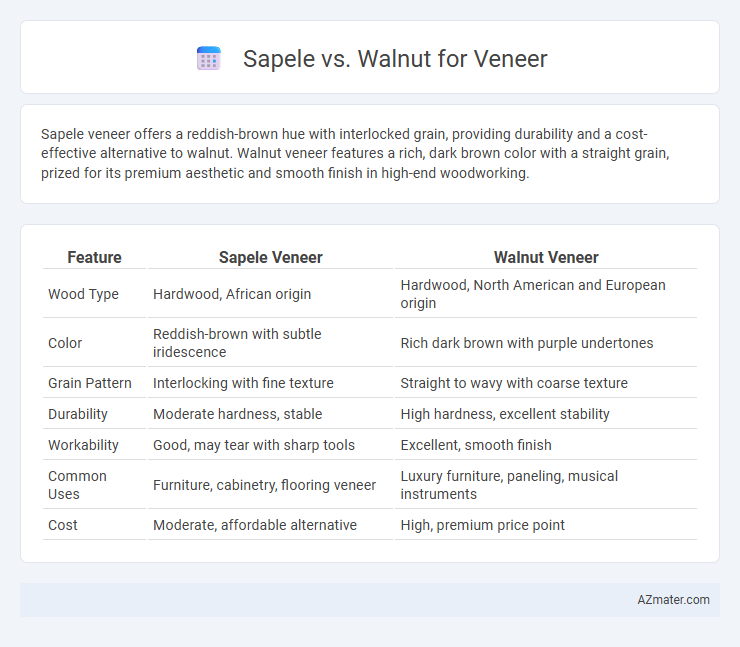Sapele veneer offers a reddish-brown hue with interlocked grain, providing durability and a cost-effective alternative to walnut. Walnut veneer features a rich, dark brown color with a straight grain, prized for its premium aesthetic and smooth finish in high-end woodworking.
Table of Comparison
| Feature | Sapele Veneer | Walnut Veneer |
|---|---|---|
| Wood Type | Hardwood, African origin | Hardwood, North American and European origin |
| Color | Reddish-brown with subtle iridescence | Rich dark brown with purple undertones |
| Grain Pattern | Interlocking with fine texture | Straight to wavy with coarse texture |
| Durability | Moderate hardness, stable | High hardness, excellent stability |
| Workability | Good, may tear with sharp tools | Excellent, smooth finish |
| Common Uses | Furniture, cabinetry, flooring veneer | Luxury furniture, paneling, musical instruments |
| Cost | Moderate, affordable alternative | High, premium price point |
Introduction: Sapele vs Walnut Veneer
Sapele veneer, sourced from the African Sapele tree, offers a rich reddish-brown hue with a fine, interlocking grain pattern, making it a popular choice for elegant furniture and cabinetry. Walnut veneer, derived from the Black Walnut tree native to North America, features a deep chocolate-brown color with a straight, sometimes wavy grain that exudes warmth and sophistication. Both veneers provide durability and aesthetic appeal, but the selection depends on the desired color tone and wood grain characteristics for the project.
Botanical Origins and Wood Characteristics
Sapele wood, derived from the *Entandrophragma cylindricum* tree native to tropical Africa, features a fine to medium texture with an interlocking grain, offering a reddish-brown hue that darkens over time. Walnut, sourced mainly from the *Juglans regia* or *Juglans nigra* species found in North America and Europe, showcases a straight to wavy grain and rich chocolate-brown coloration with purplish undertones. Both woods are prized in veneer applications for their stability and aesthetic appeal, with Sapele known for its durability and walnut valued for its elegant contrast and fine grain detail.
Appearance: Color and Grain Patterns
Sapele veneer features a rich reddish-brown color that deepens with age, showcasing interlocking grain patterns that create a striking, ribbon-like effect. Walnut veneer offers a warm, chocolate-brown hue with occasional purplish undertones and exhibits straight to wavy grain patterns that provide a smooth, elegant appearance. Both veneers present unique visual appeal, with Sapele offering a more dramatic, textured look and Walnut delivering a classic, refined aesthetic.
Workability and Machining Differences
Sapele veneer offers excellent workability with a medium texture and interlocked grain, making it easier to machine and shape without significant tear-out. Walnut veneer, known for its fine, straight grain and smooth texture, allows for more precise machining but requires sharper tools to prevent burnishing. Both veneers respond well to sanding and finishing, but Sapele's interlocked grain can challenge intricate cuts compared to Walnut's consistently uniform surface.
Durability and Hardness Comparison
Sapele veneer exhibits a Janka hardness rating of about 1,410 lbf, making it moderately durable and suitable for high-traffic areas, while walnut veneer ranks lower at approximately 1,010 lbf, indicating softer wood that is more prone to dents. Both woods offer reasonable resistance to wear, but Sapele's interlocked grain structure enhances its durability, outperforming walnut in longevity for veneer applications. Walnut veneer is favored for its rich color and aesthetic appeal, but for projects requiring higher hardness and durability, Sapele is the preferred choice.
Sustainability and Environmental Impact
Sapele veneer is harvested from sustainably managed forests in West Africa, often certified by FSC, ensuring responsible logging practices that help preserve biodiversity and reduce deforestation. Walnut veneer, primarily sourced from North American and European forests, benefits from sustainable forestry certification programs like FSC or PEFC, promoting responsible forest stewardship and carbon sequestration. Both veneers offer environmentally conscious choices, but Sapele's rapid growth rate and certification prevalence often result in a lower ecological footprint compared to slower-growing walnut species.
Price and Market Availability
Sapele veneer generally offers a more affordable price point compared to Walnut, making it a popular choice in budget-conscious projects. Walnut veneer tends to be pricier due to its rich color, grain patterns, and higher demand in high-end furniture and cabinetry. Market availability of Sapele is often more consistent and abundant, sourced primarily from West African forests, whereas Walnut veneer, especially American Black Walnut, can experience fluctuations in supply due to regional harvesting restrictions.
Best Uses in Interior Applications
Sapele veneer offers a rich, reddish-brown color with a fine, interlocking grain ideal for elegant cabinetry, paneling, and high-end furniture, providing durability and a warm aesthetic. Walnut veneer boasts deep chocolate tones with a straight grain pattern that enhances luxury interiors, making it perfect for decorative wall panels, custom millwork, and upscale flooring. Both veneers excel in interior applications, with Sapele favored for modern and classic styles, while Walnut suits more refined, sophisticated spaces.
Maintenance and Longevity
Sapele veneer offers high durability with a natural resistance to wear and requires minimal maintenance, making it an excellent choice for long-lasting surfaces. Walnut veneer, while slightly softer and more susceptible to scratches, boasts superior aging characteristics and develops a rich patina over time if properly maintained with regular cleaning and occasional polishing. Both veneers benefit from avoiding excessive moisture and direct sunlight to preserve their appearance and longevity.
Choosing the Right Veneer for Your Project
Sapele veneer offers a rich, reddish-brown color with a fine, interlocking grain pattern ideal for projects requiring durability and a warm, classic look. Walnut veneer provides a deep chocolate-brown hue and a straight, consistent grain, making it perfect for elegant, high-end furniture and cabinetry designs. When choosing between Sapele and Walnut veneer, consider factors such as color preference, grain texture, and project budget to ensure the veneer complements both the aesthetic and functional requirements of your design.

Infographic: Sapele vs Walnut for Veneer
 azmater.com
azmater.com